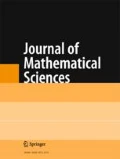We consider a system of two specially coupled differential-difference equations with delay in the coupling link. We establish that the system has a set of coexisting orbitally asymptotically stable solutions with the total number 2n, n ∈ ℕ, of bursts in the period; moreover, one of the oscillators has m bursts and the other has 2n − m bursts, m = 1, . . . , 2n−1. From the results obtained it follows that an additional delay leads to the appearance of coexisting attractors in the system with a given number of bursts in the period. Bibliography: 20 titles. Illustrations: 2 figures.
Similar content being viewed by others
References
M. I. Rabinovich, P. Varona, A. I. Selverston, and H. D. I. Abarbanel, “Dynamical principles in neuroscience,” Rev. Mod. Phys. 78, No. 4, 1213–1265 (2006).
S. Coombes and P. C. Bressloff, Bursting. The Genesis of Rhythm in the Nervous System, World Scientific, Hackensack, NJ (2005).
G. B. Ermentrout and N. Kopell, “Parabolic bursting in an excitable system coupled with a slow oscillation,” SIAM J. Appl. Math. 46, No. 2, 233–253 (1986).
D. Somers and N. Kopell, “Rapid synchronization through fast threshold modulation,” Biol. Cybern. 68, 393–407 (1993).
N. Kopell and D. Somers, “Anti-phase solutions in relaxation oscillators coupled through excitatory interactions,” J. Math. Biol. 33, No. 3, 261–280 (1995).
S. D. Glyzin, A. Yu. Kolesov, and N. Kh. Rozov, “On a method for mathematical modeling of chemical synapses,” Differ. Equ. 49, No. 10, 1193–1210 (2013).
N. Burić and D. Todorović, “Bifurcations due to small time-lag in coupled excitable systems,” Int. J. Bifurcations Chaos Appl. Sci. Eng. 15, No. 5, 1775–1785 (2005).
S. A. Campbell, Y. Yuan, and S. D. Bungay, “Equivariant Hopf bifurcation in a ring of identical cells with delayed coupling,” Nonlinearity 18, No. 6, 2827–2846 (2005).
S. Campbell, I. Ncube, and J. Wu, “Multistability and stable asynchronous periodic oscillations in a multiple-delayed neural system,” Physica D 214, No. 2, 101–119 (2006).
A. Yu. Kolesov, E. F. Mishchenko, and N. Kh. Rozov, “A modification of Hutchinsons’s equation,” Comput. Math. Math. Phys. 50, No. 12, 1990–2002 (2010).
S. Kashchenko, Models of Wave Memory, Springer, Cham (2015).
A. Yu. Kolesov, E. F. Mishchenko, and N. Kh. Rozov, “A relay with delay and its C1-approximation,” Proc. Steklov Inst. Math. 216, 119–146 (1997).
S. D. Glyzin, A. Yu. Kolesov, and N. Kh. Rozov, “Self-excited relaxation oscillations in networks of impulse neurons,” Russ. Math. Surv. 70, No. 3, 383–452 (2015).
S. D. Glyzin, A. Yu. Kolesov, and N. Kh. Rozov, “Discrete autowaves in neural systems,” Comput. Math. Math. Phys. 52, No. 5, 702–719 (2012).
M. M. Preobrazhenskaya, “Relaxation cycles in a model of synaptically interacting oscillators,” Autom. Control Comput. Sci. 51, No. 7, 783–797 (2017).
M. M. Preobrazhenskaya, “The impulse-refractive mode in a neural network with ring synaptic interaction,” Autom. Control Comput. Sci. 52, No. 7, 777–789 (2018).
M. M. Preobrazhenskaya, “Multipliers of an antiphase solution in a system of two coupled nonlinear relaxation oscillators,” J. Phys., Conf. Ser. 1163, Paper 012062 (2019).
S. D. Glyzin, A. Yu. Kolesov, and N. Kh. Rozov, “Modeling the bursting effect in neuron systems,” Math. Notes 93, No. 5, 676–690 (2013).
A. B. Vasil’eva and V. F. Butuzov, Asymptotic Methods in the Theory of Singular Perturbations [in Russian], Vysshaya Shkola, Moscow (1990).
S. D. Glyzin, A. Yu. Kolesov, and N. Kh. Rozov, “Stable relaxation cycle in a bilocal neuron model,” Differ. Equ. 54, No. 10, 1285–1309 (2018).
Author information
Authors and Affiliations
Corresponding author
Additional information
Translated from Problemy Matematicheskogo Analiza 103, 2020, pp. 71-84.
Rights and permissions
About this article
Cite this article
Glyzin, S.D., Preobrazhenskaya, M.M. Mechanism of Appearing Complex Relaxation Oscillations in a System of Two Synaptically Coupled Neurons. J Math Sci 249, 894–910 (2020). https://doi.org/10.1007/s10958-020-04982-z
Received:
Published:
Issue Date:
DOI: https://doi.org/10.1007/s10958-020-04982-z



